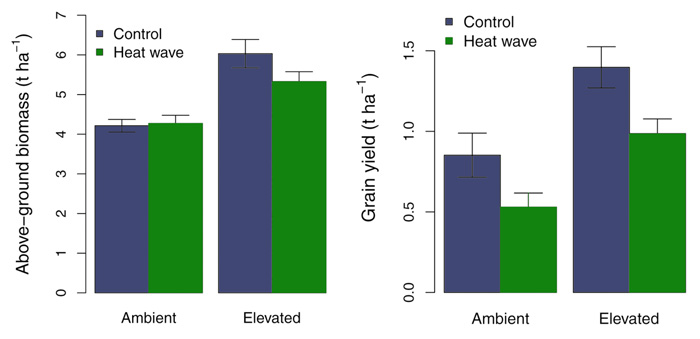| Tweet | Follow @co2science |
Paper Reviewed
Bourgault, M., Löw, M., Tausz-Posch, S., Nuttall, J.G., Delahunty, A.J., Brand, J., Panozzo, J.F., McDonald, L., O'Leary, G.J., Armstrong, R.D., Fitzgerald, G.J. and Tausz, M. 2018. Effect of a heat wave on lentil grown under Free-Air CO2 Enrichment (FACE) in a semi-arid environment. Crop Science 58: 803-812.
Much has been predicted about earth's future climate in response to increasing concentrations of atmospheric CO2. Among these predictions is the concern that there will be an increase in the frequency and severity of heat waves that will negatively impact crop production and yields. Others posit that rising atmospheric CO2 levels will benefit crop growth and productivity and enhance yields by stimulating plant photosynthesis and water use efficiency, potentially ameliorating the growth-retarding effects of more frequent/severe heat waves on plants.
Seeking to gather more information on this topic, Bourgault et al. (2018) recently investigated the combined effects of elevated CO2 and heat waves on two lentil (Lens culinaris) cultivars (PBA Ace and 05H010L-07HS3010). More specifically, using Free-Air CO2 Enrichment (FACE) technology at the Australian AGFACE facility near Horsham, Victoria, the researchers exposed the two lentil varieties to ambient (~400 ppm) or elevated (550 ppm) CO2 levels during daylight hours during the winter growing season and then exposed half of the crops in each treatment to a 3-day heat wave (approximately 15-20°C higher than ambient temperatures) at the flat pod stage. Various yield components were then analyzed at the end of the growing season to determine the net impact of these two variables, i.e., CO2 and a heat wave. The experiment was completed in two successive growing seasons (2014 and 2015) and the data from each year were pooled in calculating their results.
In discussing their findings, Bourgault et al. report that, relative to control conditions, the heat wave decreased grain yield by 33%, aboveground biomass by 6% and harvest index by 16% (see Figure 1, below). It also decreased the number of pods per square meter, the number of grains per square meter and the average number of grains per pod. Elevated CO2, in contrast, increased grain yield by 57%, aboveground biomass by 34% and harvest index by 20%. Additionally, elevated CO2 augmented the number of pods per square meter, the number of grains per square meter and the average number of grains per pod. Seed size and grain nitrogen concentration (i.e., nutrition), however, were unaffected by elevated CO2 or heat wave treatment.
Bourgault et al.'s findings are quite astounding; a relatively small 150 ppm enhancement of atmospheric CO2, during daylight hours only, was sufficient to completely ameliorate and overpower the negative effects of a massive (and likely unrealistic) 3-day, 15-20°C heatwave. Thus, it would appear that these lentil cultivars (and likely a whole lot of other crops) will greatly benefit from the ongoing rise in atmospheric CO2, regardless of whether heat waves increase or not.

Figure 1. Aboveground biomass and grain yields of two lentil lines under ambient or elevated CO2 concentrations that were subjected to normal seasonal temperatures or heat waves at the flat pod stage in the Australian Grains Free-Air CO2 Enrichment facility in 2014 and 2015. Bars represent the averages of four replicate plots over two years and two cultivars (n = 16). Adapted from Bourgault et al. (2018).




